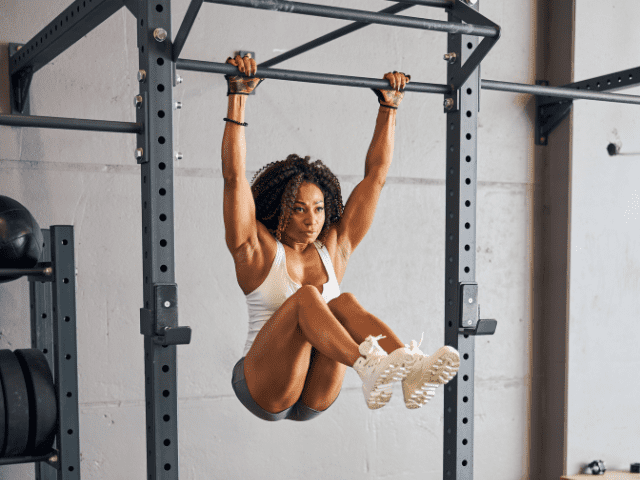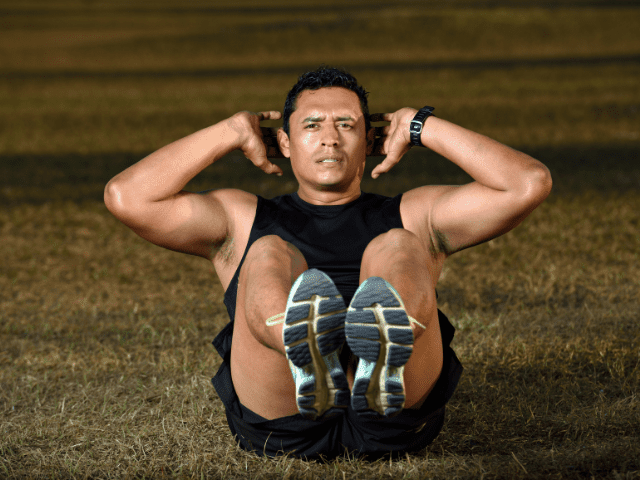Hanging Knee Raises vs Crunches (Pros and Cons)
Hanging Knee Raises and Crunches are both core exercises used to target and strengthen the abdominal muscles. But, that’s about where the similarities end.
The two exercises are very different in how they are executed, the equipment needed to do them and the level of difficulty they provide.
In this article, I’m going to teach you how to do Hanging Knee Raises and Crunches correctly and explain the benefits of each. I will also compare the two movements side-to-side so you can have a better understanding of which (or both) is a better fit for your workouts depending on your training goals and preferences.
Hanging Knee Raises

Equipment Needed
- Pull-Up Bar – Ideally a stand-alone pull-up bar or one connected to a squat rack although any sturdy object you can hang from will technically work.
Muscles Worked
- Abdominal Core Muscles (Rectus Femoris, Obliques Externus Abdominus)
- Quadriceps, Rectus Femoris
- Tensor Fasciae Latae (TFL)
- Secondarily: Back, Biceps and Forearms
Step-by-Step Instructions
- Find yourself a pull-up bar and grip the bar with an overhand grip
- Engage your lats so your body doesn’t go limp once you begin to hang
- Now hang from the bar and drive your knees up to hip height (or slightly above hip height)
- Finally, actively lower your legs back to the starting position – don’t allow the legs to just swing down
- Repeat for the designated number of reps
Coaching Points
The biggest issue that most of my athletes run into when doing Hanging Knee Raises is how to keep from swinging.
To keep from swinging, you have to actively lower your legs back down. If you ‘let your legs go’ and just allow gravity to take over you’ll completely lose control of the movement. Timing and rhythm are both important for Knee Raises and you can’t achieve either if you’re not in control of your legs throughout the movement.
Hanging Knee Raise Benefits
The most obvious benefit of Hanging Knee Raises is that they are a great core exercise. Specifically, they target the lower abs (and hip flexors). The majority of core exercises – situps, crunches, etc – involve flexing the shoulders toward the core. Far fewer involve driving the legs toward the core and Hanging Knee Raises are a great example of one of those movements.
The benefits of Hanging Knee Raises extend beyond just the abs though. They are a great way to sneak grip training into your routine. A set of 15 to 20 Knee Raises will take most lifters 20 to 30 seconds. 3 sets can account for about 90 seconds of Bar Hang time.
And don’t forget about the back and shoulders as well. Having to stabilize the position of the upper body can be a workout in itself.
Hopefully, you can see now why Hanging Knee Raises can be such a powerful addition to your strength training routine. You really do get a whole lot of ‘bang for your buck’ with them.

Tired of coming up with your own workouts? But don’t want to pay an arm and a leg?
I post workouts 5 days a week right here. (Did I mention they’re free?)
Crunches

Equipment Needed
- None
How To
- Lay flat on your back with your knees bent to 90 degrees, feet off the ground
- Place your hands behind to head and keep your chin off your chest throughout the entire movement
- Lift your shoulder blades off of the ground approximately 3 to 5 inches
- Slowly return to the starting position and immediately repeat the exercise until all reps are completed
Coaching Points
Do not pull on the back of the head. The hands behind your head should only be there to support the head, not pull on it. Keeping your chin up and away from your chest will help in preventing this.
Focus on the squeeze of the contraction at the top of the rep. It’s easy to mindlessly rep through crunches without getting much benefit out of them. Focus on each rep.
By not crossing your feet while they are in the air, you force the groin to remain active and work during the reps which can be a small added benefit.
Benefits of Crunches
Crunches are a core exercise that can be used to strengthen the abdominal muscles.
Crunches require zero equipment, making them an extremely versatile exercise that can be done pretty much anywhere at any time.
Finally, Crunches are extremely beginner-friendly. They are easy to learn and easy to perform, yet can still be a very effective movement for developing core strength.
Hanging Knee Raises vs Crunches: Which is Better?
Now, let’s take a side-by-side look at the two core movements to see if one is better than the other for a couple of common lifting goals.
Better For Developing Core Strength: Hanging Knee Raises
Whenever you’re comparing two exercises, there is a pretty simple test that will usually tell you which is better for developing strength – do them. Once you’ve tried both, ask yourself which one was harder. The answer to that question (assuming you’re doing both exercises correctly) is often the answer to which one is better for improving strength.
Having said that, if you try both Hanging Knee Raises and Crunches, it’s pretty easy to determine that Hanging Knee Raises are the more challenging movement.
Better For Beginners: Crunches
Crunches are perhaps the single best core movement for beginners to start with. They’re safe, easy to learn and easy to do (relatively speaking of course). I can teach someone how to do a Crunch and 30 seconds later they can be doing perfect reps.
Hanging Knee Raises, on the other hand, are a great core exercise but they can be too difficult for beginners, both from a technique and strength standpoint.
I would recommend beginners to start with Crunches to begin building core strength and confidence. As their strength improves, they can start to try more challenging core movements like Hanging Knee Raises.
In fact, here are 8 alternatives for Hanging Knee Raises that progress in order from easiest to most advanced.

Get Shredded… For Free
Get a free workout Monday through Friday, posted right here on Horton Barbell. These workouts are designed to help you get strong, in shape and look great at the beach!
More Links and Info
Check out how Hanging Knee Raises compare against other popular core exercises:

